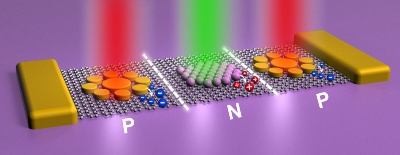Oct 11 2012
Rice University researchers are doping graphene with light in a way that could lead to the more efficient design and manufacture of electronics, as well as novel security and cryptography devices.
 Nanoscale plasmonic antennas called nonamers placed on graphene have the potential to create electronic circuits by hitting them with light at particular frequencies, according to researchers at Rice University. (credit: Rice University)
Nanoscale plasmonic antennas called nonamers placed on graphene have the potential to create electronic circuits by hitting them with light at particular frequencies, according to researchers at Rice University. (credit: Rice University)
Manufacturers chemically dope silicon to adjust its semiconducting properties. But the breakthrough reported in the American Chemical Society journal ACS Nano details a novel concept: plasmon-induced doping of graphene, the ultrastrong, highly conductive, single-atom-thick form of carbon.
That could facilitate the instant creation of circuitry – optically induced electronics – on graphene patterned with plasmonic antennas that can manipulate light and inject electrons into the material to affect its conductivity.
The research incorporates both theoretical and experimental work to show the potential for making simple, graphene-based diodes and transistors on demand. The work was done by Rice scientists Naomi Halas, Stanley C. Moore Professor in Electrical and Computer Engineering, a professor of biomedical engineering, chemistry, physics and astronomy and director of the Laboratory for Nanophotonics; and Peter Nordlander, professor of physics and astronomy and of electrical and computer engineering; physicist Frank Koppens of the Institute of Photonic Sciences in Barcelona, Spain; lead author Zheyu Fang, a postdoctoral researcher at Rice; and their colleagues.
"One of the major justifications for graphene research has always been about the electronics," Nordlander said. "People who know silicon understand that electronics are only possible because it can be p- and n-doped (positive and negative), and we're learning how this can be done on graphene.
"The doping of graphene is a key parameter in the development of graphene electronics," he said. "You can't buy graphene-based electronic devices now, but there's no question that manufacturers are putting a lot of effort into it because of its potential high speed."
Researchers have investigated many strategies for doping graphene, including attaching organic or metallic molecules to its hexagonal lattice. Making it selectively – and reversibly – amenable to doping would be like having a graphene blackboard upon which circuitry can be written and erased at will, depending on the colors, angles or polarization of the light hitting it.
The ability to attach plasmonic nanoantennas to graphene affords just such a possibility. Halas and Nordlander have considerable expertise in the manipulation of the quasiparticles known as plasmons, which can be prompted to oscillate on the surface of a metal. In earlier work, they succeeded in depositing plasmonic nanoparticles that act as photodetectors on graphene.
These metal particles don't so much reflect light as redirect its energy; the plasmons that flow in waves across the surface when excited emit light or can create "hot electrons" at particular, controllable wavelengths. Adjacent plasmonic particles can interact with each other in ways that are also tunable.
That effect can easily be seen in graphs of the material's Fano resonance, where the plasmonic antennas called nonamers, each a little more than 300 nanometers across, clearly scatter light from a laser source except at the specific wavelength to which the antennas are tuned. For the Rice experiment, those nonamers – eight nanoscale gold discs arrayed around one larger disc – were deposited onto a sheet of graphene through electron-beam lithography. The nonamers were tuned to scatter light between 500 and 1,250 nanometers, but with destructive interference at about 825 nanometers.
At the point of destructive interference, most of the incident light energy is converted into hot electrons that transfer directly to the graphene sheet and change portions of the sheet from a conductor to an n-doped semiconductor.
Arrays of antennas can be affected in various ways and allow phantom circuits to materialize under the influence of light. "Quantum dot and plasmonic nanoparticle antennas can be tuned to respond to pretty much any color in the visible spectrum," Nordlander said. "We can even tune them to different polarization states, or the shape of a wavefront.
"That's the magic of plasmonics," he said. "We can tune the plasmon resonance any way we want. In this case, we decided to do it at 825 nanometers because that is in the middle of the spectral range of our available light sources. We wanted to know that we could send light at different colors and see no effect, and at that particular color see a big effect."
Nordlander said he foresees a day when, instead of using a key, people might wave a flashlight in a particular pattern to open a door by inducing the circuitry of a lock on demand. "Opening a lock becomes a direct event because we are sending the right lights toward the substrate and creating the integrated circuits. It will only answer to my call," he said.